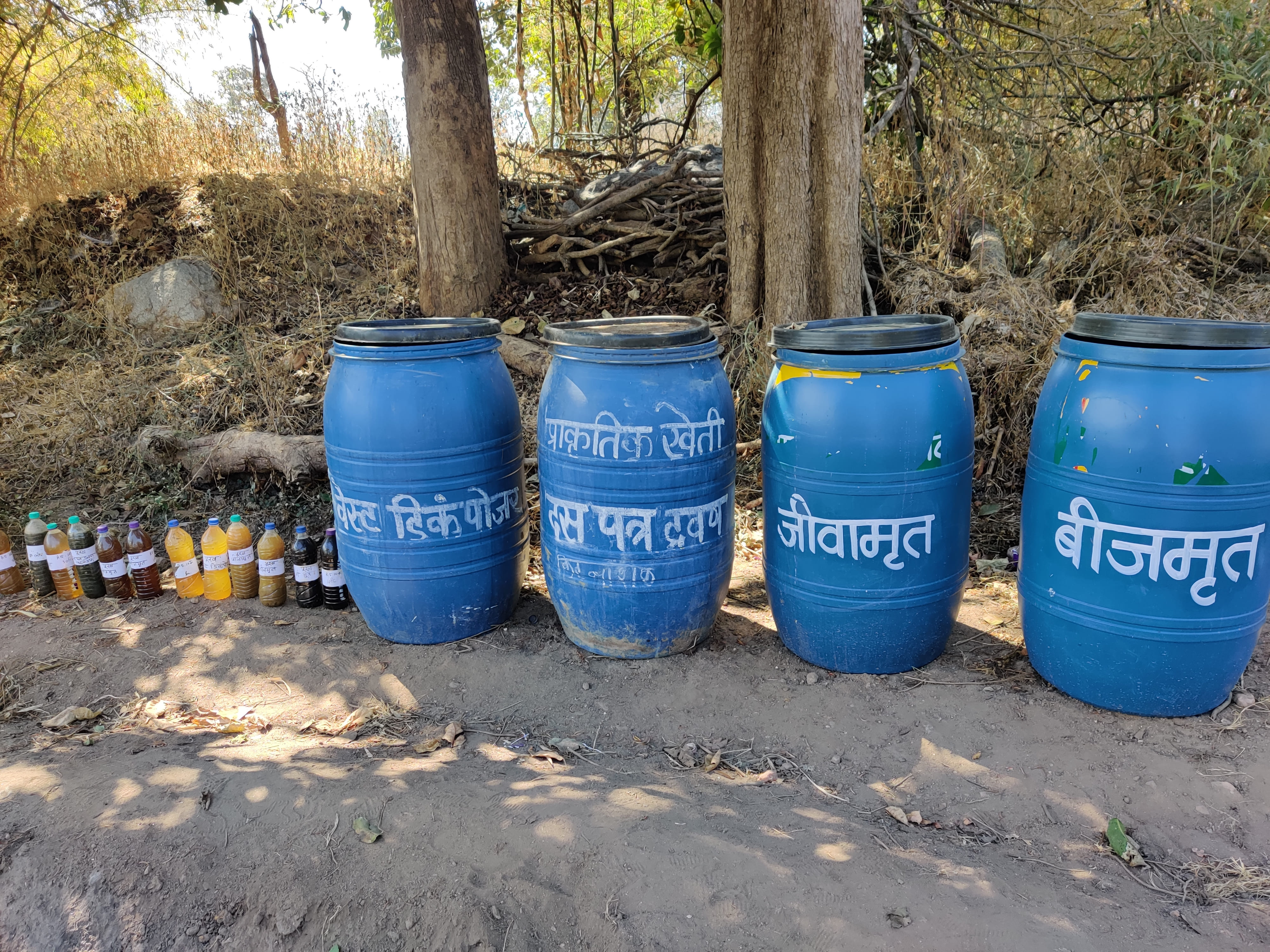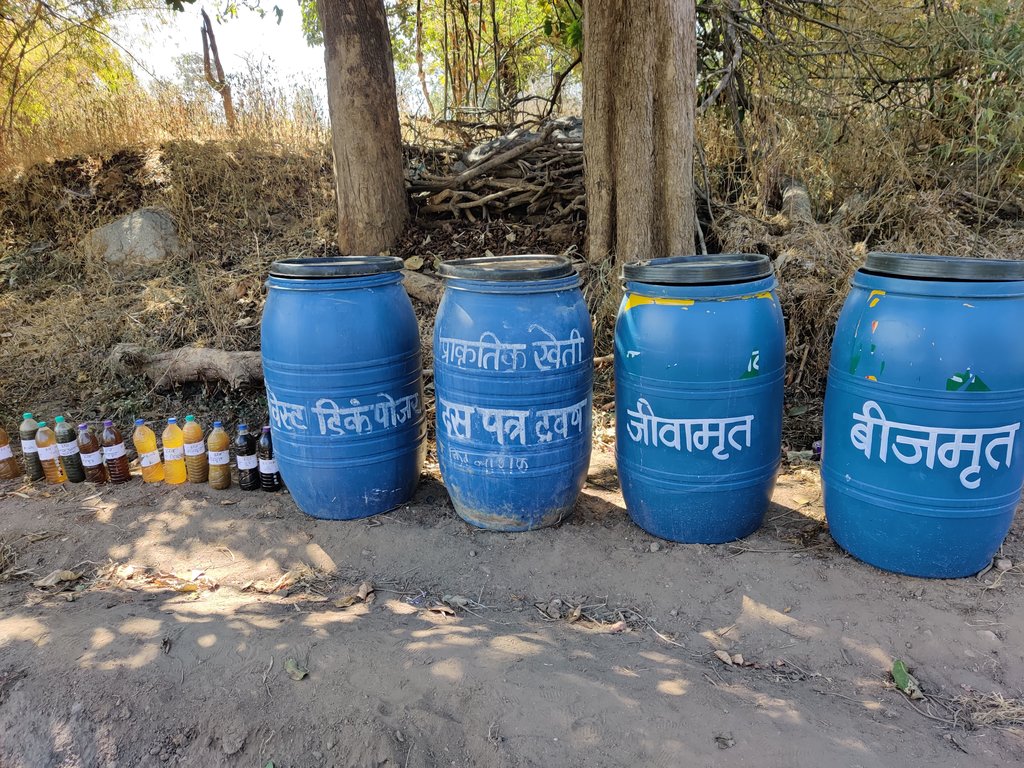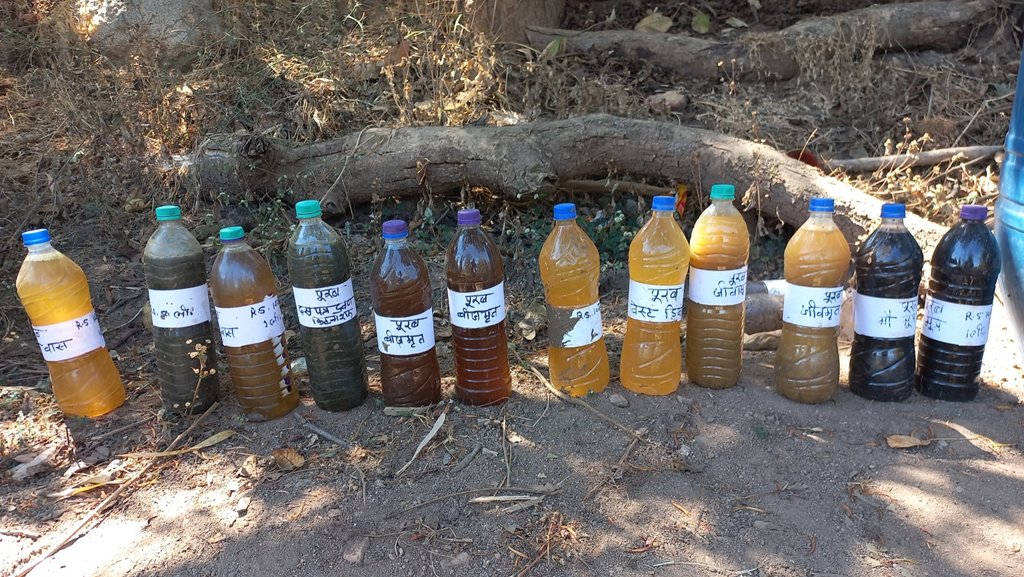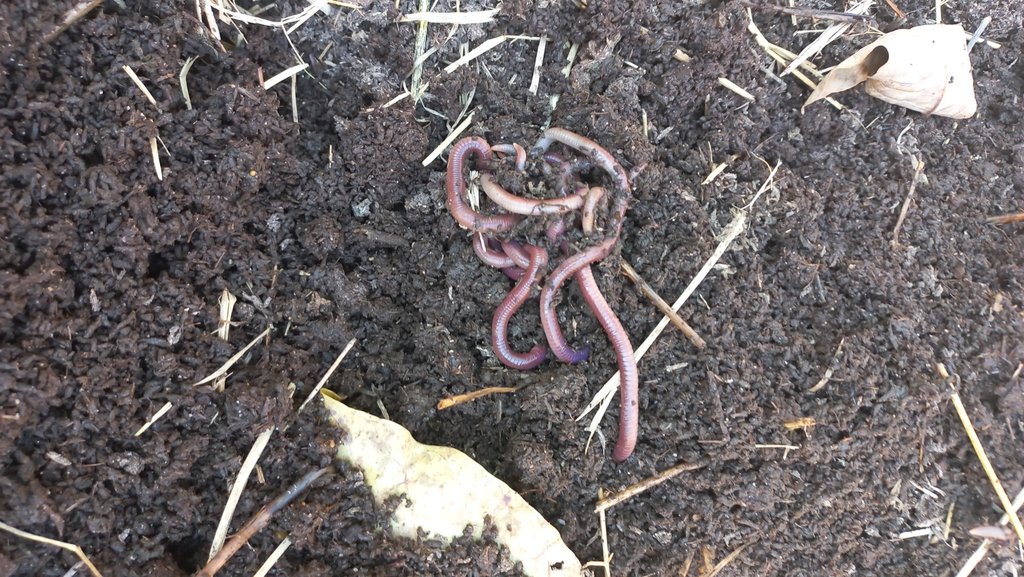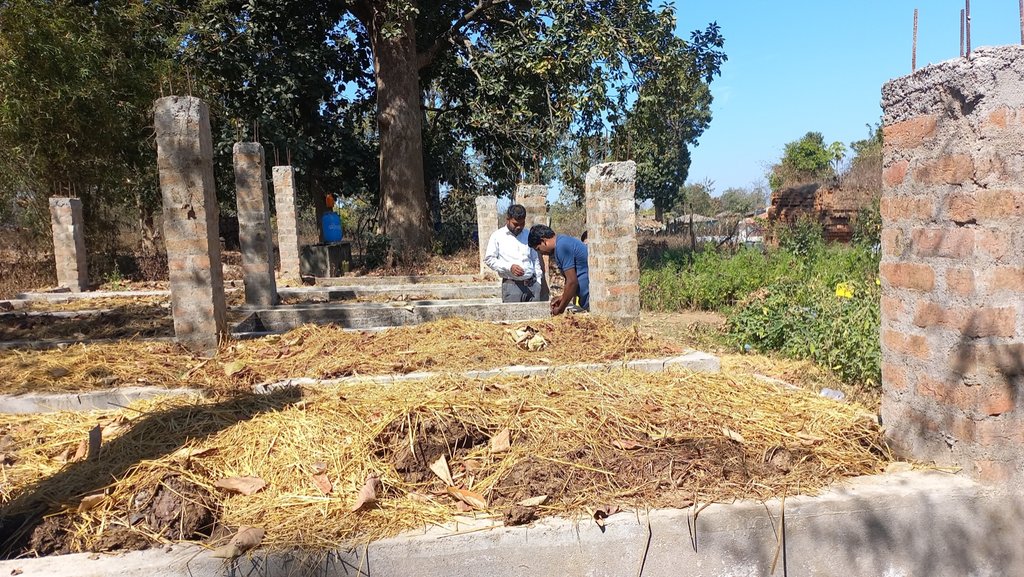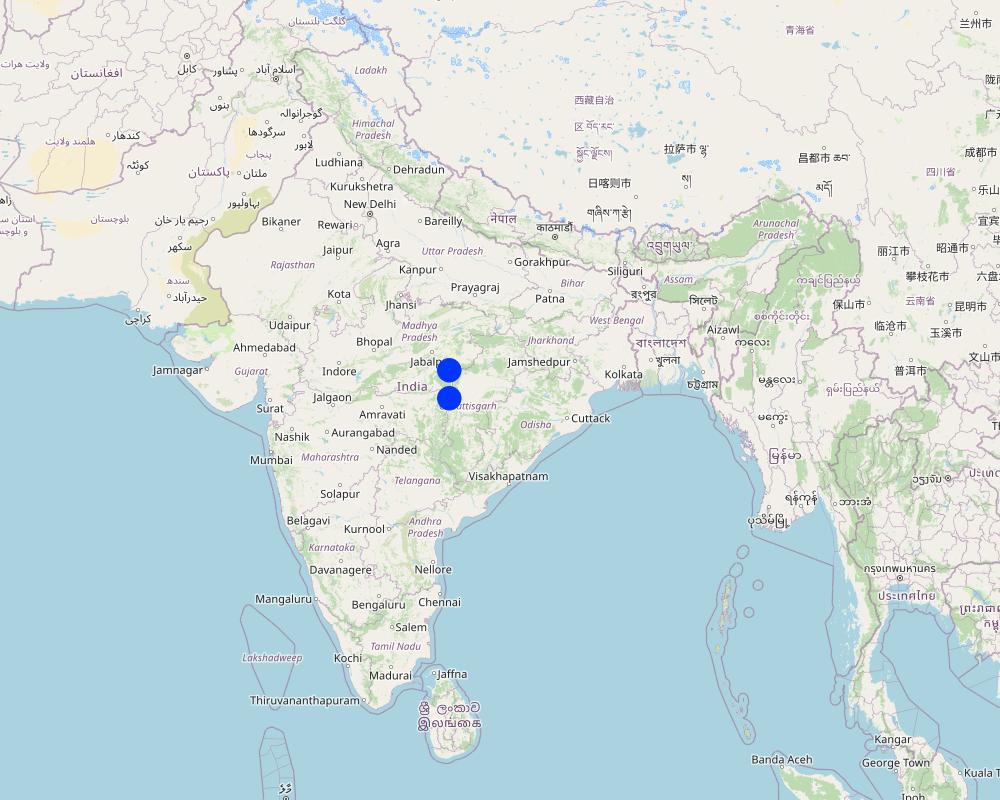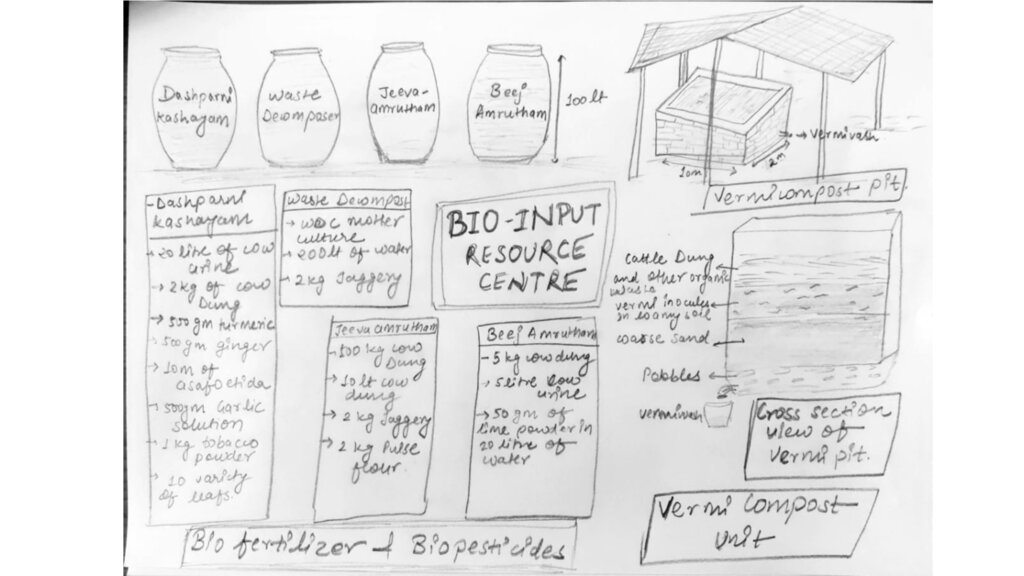Preparation of Bio-Inputs such as Vermicompost, Biofertilizers, and Biopesticides [อินเดีย]
- ผู้สร้างสรรค์:
- การอัพเดท:
- ผู้รวบรวม: Santosh Gupta
- ผู้เรียบเรียง: Noel Templer, Stephanie Katsir, Kim Arora, Tabitha Nekesa, Ahmadou Gaye, Siagbé Golli
- ผู้ตรวจสอบ: Udo Höggel, Joana Eichenberger, Sally Bunning
Kechua khaad, Beej Amrutham, Jeevamrutham, Dashparni and compost
technologies_6695 - อินเดีย
- บทสรุปทั้งหมดในรูปแบบของ PDF
- บทสรุปทั้งหมดในรูปแบบของ PDF เพื่อพิมพ์
- บทสรุปทั้งหมดในรูปหน้าเว็บ
- บทสรุปทั้งหมด (ไม่มีการจัดเรียง)
- Preparation of Bio-Inputs such as Vermicompost, Biofertilizers, and Biopesticides: 25 มิถุนายน 2023 (inactive)
- Preparation of Bio-Inputs such as Vermicompost, Biofertilizers, and Biopesticides: 14 กันยายน 2023 (inactive)
- Preparation of Bio-Inputs such as Vermicompost, Biofertilizers, and Biopesticides: 17 เมษายน 2024 (public)
ดูส่วนย่อย
ขยายทั้งหมด ย่อทั้งหมด1. ข้อมูลทั่วไป
1.2 รายละเอียดที่ติดต่อได้ของผู้รวบรวมและองค์กรที่เกี่ยวข้องในการประเมินและการจัดเตรียมทำเอกสารของเทคโนโลยี
ชื่อของโครงการซึ่งอำนวยความสะดวกในการทำเอกสารหรือการประเมินเทคโนโลยี (ถ้าเกี่ยวข้อง)
Soil protection and rehabilitation for food security (ProSo(i)l)ชื่อขององค์กรซึ่งอำนวยความสะดวกในการทำเอกสารหรือการประเมินเทคโนโลยี (ถ้าเกี่ยวข้อง)
Deutsche Gesellschaft für Internationale Zusammenarbeit (GIZ) - เยอรมนีชื่อขององค์กรซึ่งอำนวยความสะดวกในการทำเอกสารหรือการประเมินเทคโนโลยี (ถ้าเกี่ยวข้อง)
CIAT International Center for Tropical Agriculture (CIAT International Center for Tropical Agriculture) - เคนยาชื่อขององค์กรซึ่งอำนวยความสะดวกในการทำเอกสารหรือการประเมินเทคโนโลยี (ถ้าเกี่ยวข้อง)
Ecociate Consultants (Ecociate Consultants) - อินเดีย1.3 เงื่อนไขการใช้ข้อมูลที่ได้บันทึกผ่านทาง WOCAT
ผู้รวบรวมและวิทยากรหลักยอมรับเงื่อนไขเกี่ยวกับการใช้ข้อมูลที่ถูกบันทึกผ่านทาง WOCAT:
ใช่
1.4 การเปิดเผยเรื่องความยั่งยืนของเทคโนโลยีที่ได้อธิบายไว้
เทคโนโลยีที่ได้อธิบายไว้นี้เป็นปัญหาของความเสื่อมโทรมโทรมของที่ดินหรือไม่ จึงไม่ได้รับการยอมรับว่าเป็นเทคโนโลยีเพื่อการจัดการที่ดินอย่างยั่งยืน:
ไม่ใช่
2. การอธิบายลักษณะของเทคโนโลยี SLM
2.1 การอธิบายแบบสั้น ๆ ของเทคโนโลยี
คำจำกัดความของเทคโนโลยี:
Bioresource Center (BRC) is an enterprise model to promote the preparation and commercialization of bio-inputs to help farmers adopt natural and sustainable agriculture practices. The bio-inputs and composting material under such models are prepared using locally available material at very affordable prices.
2.2 การอธิบายแบบละเอียดของเทคโนโลยี
คำอธิบาย:
Bioresource Center (BRC) is a community-led enterprise to produce bio-inputs and compost from locally available bioresources for improving soil health and fertility, managing pest and disease, and meeting the nutrient requirement for the crops. BRCs have been envisaged as a potential enterprise solution to meet the requirements of small and marginal farmers who do not have time and resources to make their own bio-inputs and composting material. Such farmers can purchase the bio-inputs at very affordable prices from the BRCs being operated by either individual entrepreneurs or community-based institutions of male and female farmers.
Essentially it is an enterprise-led platform that can create the necessary conditions to scale the adoption of better farming practices. The technology for bioresource units is applied in both natural and human environments to promote sustainable agriculture and improve livelihoods in rural communities. The establishment and maintenance of a bioresource unit require inputs such as organic waste materials, earthworms, inoculants, and water, as well as activities such as vermicomposting, biofertilizer and biopesticide production, training and capacity building, and monitoring and evaluation.
The technological inputs produced include various type of tried and tested local formulations like microbial preparations such as Jeevamrut (Soil life elixir), Ghana Jeevamrith(compact and aggregated form of Soil Life Elixir), Beejamrut (Microbial Seed Dressing), Waste Decomposer, etc.; botanical decoctions like Panchagavya ( 5 cow based products formulation - Milk, Curd, cow-urine, cow-dung, ghee), Dashparni (Extract of 10 leaves available locally), Neemastra (Extarct of Neem leaves and seeds (Azadirachta indica), Brahmastra (Referes to the highly effective pest controlling material made out of chilli, garlic and other local materials), agniastra (Refers to the fire powering material for controlling pest), NSKE (Neem seed kernel extract) ; and biopesticides cultures like Beauveria, Verticillium, Trichoderma, Pseudo-monas, NPV formulations/cultures. Beyond this, the platform enables the supply of seeds of green manuring crops, vermiculture/compost, Neem / karanj cake, Cow dung/cow urine, briquets, seeds/seedlings of trap crops, etc. For a detailed list of different sub-technologies - preparations, their ingredients and processing one can refer to BIO-INPUT RESOURCE CENTER MANUAL FROM NATIONAL COALITION FOR NATURAL FARMING at: (https://indiaclimatecollaborative.org/wp-content/uploads/2022/09/BRC-Technical-manual.pdf)
This technology does not require much investment and material. 2-3 plastic containers of 200 litres and 2-3 containers of 100 litres or any other locally available utensil are good enough to make these bio-inputs. The preparation method for each of the inputs is a bit different from each other, while some of the inputs are being prepared by extracting the paste from leaves or other materials like chilli, garlic etc, others are prepared by mixing them with cow dung and cow urine. Cow urine is one of the most important substances for preparing these inputs. The urine of indigenous cows are considered more effective for preparing these inputs. The document shared above can be refereed to for the preparation method of each of the bio-inputs.
The bioresource unit technology has numerous benefits and impacts, including improved soil health, reduced dependence on synthetic inputs, increased crop yields, reduced environmental impact, enhanced biodiversity, reduced greenhouse gas emissions, and improved human health. Land users generally appreciate the benefits of the bioresource unit technology, particularly its cost-effectiveness, improved soil health, and reduced environmental impact. However, there are also challenges related to the labor-intensiveness of the technology, the need for technical knowledge, and the dependence on local resources.
By using natural inputs and locally available resources, this technology can help to create a more sustainable and equitable food system for people and for land also. These functions contribute to a healthier environment, healthier crops, and healthier communities.
2.3 รูปภาพของเทคโนโลยี
2.4 วีดีโอของเทคโนโลยี
ความคิดเห็น/อธิบายสั้นๆ:
Video of the technology
https://www.youtube.com/watch?v=hW2xEpWyIa8
Hindi narration of the bioinput resource center during the field visit.
วันที่:
19/03/2023
สถานที่:
Mandla, Madhya Pradesh, India
ชื่อผู้ถ่ายวีดีโอ:
Santosh Gupta
2.5 ประเทศภูมิภาค หรือสถานที่ตั้งที่เทคโนโลยีได้นำไปใช้และได้รับการครอบคลุมโดยการประเมินนี้
ประเทศ:
อินเดีย
ภูมิภาค/รัฐ/จังหวัด:
Madhya Pradesh
ข้อมูลจำเพาะเพิ่มเติมของสถานที่ตั้ง :
Bichhiya Block, Mandla District, Madhya Pradesh
ระบุการกระจายตัวของเทคโนโลยี:
- ใช้ ณ จุดที่เฉพาะเจาะจงหรือเน้นไปยังบริเวณพื้นที่ขนาดเล็ก
Is/are the technology site(s) located in a permanently protected area?
ไม่ใช่
แสดงความคิดเห็น:
The technology was implemented in some of the selected villages of the Bichhiya Block in the Mandla District of Madhya Pradesh. These villages are located in and around a tiger reserve park.
Map
×2.6 วันที่การดำเนินการ
ระบุปีที่ใช้:
2018
2.7 คำแนะนำของเทคโนโลยี
ให้ระบุว่าเทคโนโลยีถูกแนะนำเข้ามาอย่างไร:
- ด้วยการริเริ่มของผู้ใช้ที่ดินเอง
- ในช่วงการทดลองหรือการทำวิจัย
- ทางโครงการหรือจากภายนอก
3. การจัดประเภทของเทคโนโลยี SLM
3.1 วัตถุประสงค์หลักของเทคโนโลยี
- ปรับปรุงการผลิตให้ดีขึ้น
- ลด ป้องกัน ฟื้นฟู การเสื่อมโทรมของที่ดิน
- อนุรักษ์ระบบนิเวศน์
- รักษาสภาพหรือปรับปรุงความหลากหลายทางชีวภาพ
- ปรับตัวเข้ากับการเปลี่ยนแปลงภูมิอากาศของโลก สภาพภูมิอากาศที่รุนแรงและผลกระทบ
- สร้างผลกระทบทางด้านเศรษฐกิจที่เป็นประโยชน์
- Control pest and diseases
3.2 ประเภทของการใช้ที่ดินในปัจจุบันที่ได้นำเทคโนโลยีไปใช้
Land use mixed within the same land unit:
ไม่ใช่

พื้นที่ปลูกพืช
- การปลูกพืชล้มลุกอายุปีเดียว
Annual cropping - Specify crops:
- oilseed crops - sunflower, rapeseed, other
- cereals - wheat (winter)
- cereals - maize
- cereals - rice (wetland)
- legumes and pulses - lentils
- vegetables - leafy vegetables (salads, cabbage, spinach, other)
จำนวนของฤดูเพาะปลูกต่อปี:
- 2
ระบุ:
During the monsoon, farmers are cultivating the rice while during the winter season they are growing wheat, chick-pea, mustard and other crops
Is intercropping practiced?
ใช่
If yes, specify which crops are intercropped:
Chick pea intercropped with beans, mixed cropping system of vegetables
Is crop rotation practiced?
ใช่
ถ้าใช่ ระบุ:
Rice-Chick pea, Rice-Wheat
แสดงความคิดเห็น:
The technology has enabled farmers to get easy access to bio-inputs, which has led to the adoption of natural and sustainable farming practices in the field. This has also promoted mixed farming systems among the farmers as natural farming is more suited to such cropping systems.
3.3 Has land use changed due to the implementation of the Technology?
Has land use changed due to the implementation of the Technology?
- No (Continue with question 3.4)
แสดงความคิดเห็น:
The land use pattern remained same. Farmers are cultivating the crops both before and after the intervention.
3.4 การใช้น้ำ
การใช้น้ำของที่ดินที่มีการใช้เทคโนโลยีอยู่:
- น้ำฝนร่วมกับการชลประทาน
แสดงความคิดเห็น:
Most farmers cultivate under rainfed conditions due to the unavailability of any external irrigation facility. There are a few farmers who apply irrigation.
3.5 กลุ่ม SLM ที่ตรงกับเทคโนโลยีนี้
- การจัดการปลูกพืชร่วมกับปศุสัตว์
- การจัดการความอุดมสมบรูณ์ของดินแบบผสมผสาน
- การจัดการศัตรูพืชและโรคพืชแบบผสมผสาน (รวมถึงเกษตรอินทรีย์ด้วย)
3.6 มาตรการ SLM ที่ประกอบกันเป็นเทคโนโลยี

มาตรการจัดการพืช
- A2: อินทรียวัตถุในดิน/ความอุดมสมบูรณ์ในดิน
- A4: การรักษาดินชั้นล่าง
- A6: Residue management
A6: Specify residue management:
A 6.4: retained

มาตรการอื่น ๆ
ระบุ:
Pest and diseases management measures to reduce the use of chemical fertilizers and pesticides
แสดงความคิดเห็น:
Bio-inputs are an effective alternative to reduce or replace the use of synthetic fertilisers and pesticides. The use of these inputs ensure lesser pollution of air and water, safe food and improved biodiversity.
3.7 รูปแบบหลักของการเสื่อมโทรมของที่ดินที่ได้รับการแก้ไขโดยเทคโนโลยี

การเสื่อมโทรมของดินทางด้านเคมี
- Cn (Fertility decline): ความอุดมสมบูรณ์และปริมาณอินทรียวัตถุในดินถูกทำให้ลดลงไป (ไม่ได้เกิดจากสาเหตุการกัดกร่อน)
- Cp (Soil pollution): มลพิษในดิน

การเสื่อมโทรมของดินทางด้านชีวภาพ
- Bp (Increase of pests/diseases): การเพิ่มขึ้นของศัตรูพืชและโรคพืช

การเสื่อมโทรมของน้ำ
- Hp (Decline of surface water quality): การลดลงของคุณภาพน้ำที่ผิวดิน
แสดงความคิดเห็น:
Control over pest and disease along with improved soil microbial activity as an outcome of vermicompost application has ensured better soil health and improved production.
3.8 การป้องกัน การลดลง หรือการฟื้นฟูความเสื่อมโทรมของที่ดิน
ระบุเป้าหมายของเทคโนโลยีกับความเสื่อมโทรมของที่ดิน:
- ลดความเสื่อมโทรมของดิน
4. ข้อมูลจำเพาะด้านเทคนิค กิจกรรมการนำไปปฏิบัติใช้ ปัจจัยนำเข้า และค่าใช้จ่าย
4.1 แบบแปลนทางเทคนิคของเทคโนโลยี
ข้อมูลจำเพาะด้านเทคนิค (แบบแปลนทางเทคนิคของเทคโนโลยี):
The drawing indicates the overall flow and design of the bioresource unit as seen in one of the enterprises in the project area. It consists of vermicompost pits of 6ft in length, 4 ft in depth, and 2 ft in width. The enterprise has 10 such pits. The drawing also covers the placement and structure of other equipment such as vermiwash and bio-inoculate units.
ผู้เขียน:
Payal
วันที่:
08/03/2023
4.2 ข้อมูลทั่วไปเกี่ยวกับการคำนวณปัจจัยนำเข้าและค่าใช้จ่าย
ให้ระบุว่าค่าใช้จ่ายและปัจจัยนำเข้าได้รับการคำนวณอย่างไร:
- ต่อหน่วยเทคโนโลยี
โปรดระบุหน่วย:
Vermicompost unit is a pit, biofertilizer and pesticides unit in litre, Materials is in Kg
If relevant, indicate exchange rate from USD to local currency (e.g. 1 USD = 79.9 Brazilian Real): 1 USD =:
82.0
ระบุค่าเฉลี่ยของค่าจ้างในการจ้างแรงงานต่อวัน:
3
4.3 กิจกรรมเพื่อการจัดตั้ง
| กิจกรรม | Timing (season) | |
|---|---|---|
| 1. | Digging for vermicompost pits | October |
| 2. | Construction of vermicompost pit | October |
| 3. | Construction of Cattle Management Shed | March |
4.4 ค่าใช้จ่ายของปัจจัยนำเข้าที่จำเป็นสำหรับการจัดตั้ง
| ปัจจัยนำเข้า | หน่วย | ปริมาณ | ค่าใช้จ่ายต่อหน่วย | ค่าใช้จ่ายทั้งหมดต่อปัจจัยนำเข้า | %ของค่าใช้จ่ายที่ก่อให้เกิดขึ้นโดยผู้ใช้ที่ดิน | |
|---|---|---|---|---|---|---|
| แรงงาน | Digging for vermicompost pit | piece | 2.0 | 1000.0 | 2000.0 | 100.0 |
| แรงงาน | Construction of vermicompost pit | piece | 2.0 | 4000.0 | 8000.0 | 100.0 |
| อุปกรณ์ | Drum 500 lts | piece | 5.0 | 600.0 | 3000.0 | 100.0 |
| วัสดุด้านพืช | Pulse flour | Kg | 3.0 | 70.0 | 210.0 | 100.0 |
| วัสดุด้านพืช | Jageery | Kg | 3.0 | 60.0 | 180.0 | 100.0 |
| วัสดุด้านพืช | Turmeric | Kg | 0.5 | 100.0 | 50.0 | 100.0 |
| วัสดุด้านพืช | Ginger paste | Kg | 0.5 | 120.0 | 60.0 | 100.0 |
| วัสดุด้านพืช | Asafoetida | Gramm | 10.0 | 3.0 | 30.0 | 100.0 |
| วัสดุด้านพืช | Chillies | Kg | 1.0 | 100.0 | 100.0 | 100.0 |
| วัสดุด้านพืช | Garlic | Kg | 0.5 | 160.0 | 80.0 | 100.0 |
| วัสดุด้านพืช | Tobbaco | Kg | 0.5 | 200.0 | 100.0 | 100.0 |
| ปุ๋ยและสารฆ่า/ยับยั้งการเจริญเติบโตของสิ่งมีชีวิต (ไบโอไซด์) | Cow dung | Kg | 120.0 | 2.0 | 240.0 | 100.0 |
| ปุ๋ยและสารฆ่า/ยับยั้งการเจริญเติบโตของสิ่งมีชีวิต (ไบโอไซด์) | Cow urine | Litre | 25.0 | 5.0 | 125.0 | 100.0 |
| ปุ๋ยและสารฆ่า/ยับยั้งการเจริญเติบโตของสิ่งมีชีวิต (ไบโอไซด์) | Lime | Gramm | 50.0 | 0.25 | 12.5 | 100.0 |
| ปุ๋ยและสารฆ่า/ยับยั้งการเจริญเติบโตของสิ่งมีชีวิต (ไบโอไซด์) | Farm Yard Manure for Vermicompost | Kg | 1000.0 | 10.0 | 10000.0 | 100.0 |
| วัสดุสำหรับก่อสร้าง | Brick | Piece | 100.0 | 10.0 | 1000.0 | 100.0 |
| วัสดุสำหรับก่อสร้าง | Cement | Sack | 3.0 | 300.0 | 900.0 | 100.0 |
| วัสดุสำหรับก่อสร้าง | Stone | Sack | 2.0 | 500.0 | 1000.0 | 100.0 |
| อื่น ๆ | Vermi inocules | Kg | 40.0 | 450.0 | 18000.0 | 100.0 |
| ค่าใช้จ่ายทั้งหมดของการจัดตั้งเทคโนโลยี | 45087.5 | |||||
| Total costs for establishment of the Technology in USD | 549.85 | |||||
4.5 การบำรุงรักษาสภาพหรือกิจกรรมที่เกิดขึ้นเป็นประจำ
| กิจกรรม | ช่วงระยะเวลา/ความถี่ | |
|---|---|---|
| 1. | Preparations | Every season |
| 2. | Packaging and Selling | Everyseason |
| 3. | Capacity building | Every season |
| 4. | Application at field | Kharif and Rabi Seaon |
| 5. | Harvesting of vermicompost | In every 3 months |
| 6. | Filling of pit | In every 3 months after Harvesting |
4.6 ค่าใช้จ่ายของปัจจัยนำเข้าและกิจกรรมที่เกิดขึ้นเป็นประจำที่ต้องการการบำรุงรักษา (ต่อปี)
| ปัจจัยนำเข้า | หน่วย | ปริมาณ | ค่าใช้จ่ายต่อหน่วย | ค่าใช้จ่ายทั้งหมดต่อปัจจัยนำเข้า | %ของค่าใช้จ่ายที่ก่อให้เกิดขึ้นโดยผู้ใช้ที่ดิน | |
|---|---|---|---|---|---|---|
| แรงงาน | Preparation of bio-inputs | Person days | 50.0 | 200.0 | 10000.0 | 100.0 |
| แรงงาน | Packaging, marketing | Person days | 10.0 | 250.0 | 2500.0 | 100.0 |
| ปุ๋ยและสารฆ่า/ยับยั้งการเจริญเติบโตของสิ่งมีชีวิต (ไบโอไซด์) | Cow dung or FYM for filling pit | Kg | 100.0 | 10.0 | 1000.0 | 100.0 |
| ปุ๋ยและสารฆ่า/ยับยั้งการเจริญเติบโตของสิ่งมีชีวิต (ไบโอไซด์) | Different material to prepare bio-inputs | kg | 200.0 | 15.0 | 3000.0 | 100.0 |
| อื่น ๆ | Packaging and Selling | Sack | 100.0 | 5.0 | 500.0 | 100.0 |
| ค่าใช้จ่ายทั้งหมดของการบำรุงรักษาสภาพเทคโนโลยี | 17000.0 | |||||
| Total costs for maintenance of the Technology in USD | 207.32 | |||||
แสดงความคิดเห็น:
After harvesting of vermicompost, maintenance of the pit is required by refilling pit with farm yard manure (FYM). For selling biofertilizers and biopesticides new batch preparation incl. all input materials is required.
4.7 ปัจจัยสำคัญที่สุดที่มีผลกระทบต่อค่าใช้จ่าย
ปัจจัยสำคัญที่สุดที่มีผลกระทบต่อค่าใช้จ่ายต่างๆ:
The availability of locally available raw materials and labor
5. สิ่งแวดล้อมทางธรรมชาติและของมนุษย์
5.1 ภูมิอากาศ
ฝนประจำปี
- < 250 ม.ม.
- 251-500 ม.ม.
- 501-750 ม.ม.
- 751-1,000 ม.ม.
- 1,001-1,500 ม.ม.
- 1,501-2,000 ม.ม.
- 2,001-3,000 ม.ม.
- 3,001-4,000 ม.ม.
- > 4,000 ม.ม.
ระบุปริมาณน้ำฝนเฉลี่ยรายปี (ถ้ารู้) :หน่วย ม.ม.
1427.00
ข้อมูลจำเพาะ/ความคิดเห็นเรื่องปริมาณน้ำฝน:
The highest rainfall period is from June to September during the monsoon season.
ระบุชื่อของสถานีตรวดวัดอากาศที่ใช้อ้างอิงคือ:
Mandla, Madhya Pradesh
เขตภูมิอากาศเกษตร
- กึ่งแห้งแล้ง
The climate of the district is tropical, with moderate winters, severe summers, and well-distributed rainfall received from the southwest monsoon. However, due to higher general elevation and abundance of forests, summer temperatures do not rise as much as in other areas.
5.2 สภาพภูมิประเทศ
ค่าเฉลี่ยความลาดชัน:
- ราบเรียบ (0-2%)
- ลาดที่ไม่ชัน (3-5%)
- ปานกลาง (6-10%)
- เป็นลูกคลื่น (11-15%)
- เป็นเนิน (16-30%)
- ชัน (31-60%)
- ชันมาก (>60%)
ธรณีสัณฐาน:
- ที่ราบสูง/ที่ราบ
- สันเขา
- ไหล่เขา
- ไหล่เนินเขา
- ตีนเนิน
- หุบเขา
ระดับความสูง:
- 0-100 เมตร
- 101-500 เมตร
- 501-1,000 เมตร
- 1,001-1,500 เมตร
- 1,501-2,000 เมตร
- 2,001-2,500 เมตร
- 2,501-3,000 เมตร
- 3,001-4,000 เมตร
- > 4,000 เมตร
ให้ระบุถ้าเทคโนโลยีได้ถูกนำไปใช้:
- ไม่เกี่ยวข้อง
ความคิดเห็นและข้อมูลจำเพาะเพิ่มเติมเรื่องสภาพภูมิประเทศ:
The topography of the project area consists of a hilly area and a forest area. Mandla district is hilly and forested (Satpura hill range) and highly undulating with a narrow strip of cultivated plains in the valley portion of the river. The plateau is in the northern part formed by basalt, and east-west trending hills in the southern part. The highest elevation is 934 m amsl in the northern part, and the lowest is around 400 m amsl in the northwestern part of the area. The elevation of the studied block Bichhiya is 453 m amsl.
Source: District at a glance; Ministry of water resources, Government of Madhya Pradesh
5.3 ดิน
ค่าเฉลี่ยความลึกของดิน:
- ตื้นมาก (0-20 ซ.ม.)
- ตื้น (21-50 ซ.ม.)
- ลึกปานกลาง (51-80 ซ.ม.)
- ลึก (81-120 ซ.ม.)
- ลึกมาก (>120 ซ.ม.)
เนื้อดิน (ดินชั้นบน):
- หยาบ/เบา (ดินทราย)
- ปานกลาง (ดินร่วน ทรายแป้ง)
เนื้อดินล่าง (> 20 ซ.ม.ต่ำจากผิวดิน):
- ปานกลาง (ดินร่วน ทรายแป้ง)
อินทรียวัตถุในดิน:
- ต่ำ (<1%)
(ถ้ามี) ให้แนบคำอธิบายเรื่องดินแบบเต็มหรือระบุข้อมูลที่มีอยู่ เช่น ชนิดของดิน ค่า pH ของดินหรือความเป็นกรดของดิน ความสามารถในการแลกเปลี่ยนประจุบวก ไนโตรเจน ความเค็ม เป็นต้น:
Soil Testing Parameter status (Average) 2017-20 for the project areas is as follows. This data is based on the soil samples tested by the FES in its soil labs from the project villages:
Soil pH:- 5.906548628; EC (electrical conductivity):- 0.122993577; Soil Organic Carbon:- 0.83%; Nitrogen:- 293.3696598; Phosphorus:- 25.77762582; Potassium (K):- 139.6696636; Sulphur (S):-18.93457993; Zinc (Zn):- 0.955246706; Boron (Bn):- 0.490850376
5.4 ความเป็นประโยชน์และคุณภาพของน้ำ
ระดับน้ำใต้ดิน:
> 50 เมตร
น้ำไหลบ่าที่ผิวดิน:
ปานกลาง
คุณภาพน้ำ (ที่ยังไม่ได้บำบัด):
เป็นน้ำเพื่อการดื่มที่ไม่ดี (จำเป็นต้องได้รับการบำบัด)
Water quality refers to:
both ground and surface water
ความเค็มของน้ำเป็นปัญหาหรือไม่:
ไม่ใช่
กำลังเกิดน้ำท่วมในพื้นที่หรือไม่:
ไม่ใช่
ความคิดเห็นและข้อมูลจำเพาะเพิ่มเติมเรื่องคุณภาพและปริมาณน้ำ:
The groundwater status is within the safe limits as per the reports by the Government of Madhya Pradesh. People use water from rivers, streams, and traditional small wells for domestic purposes. In the absence of good vegetative cover, the rainwater washes off the fertile topsoil from the farmlands making the land barren and resulting in the siltation of ponds and other water bodies. Further, a heavy infestation of invasive species such as Lantana Camara compounds the degradation.
The studied block Bichhiya is in a better position in terms of stage of groundwater Development with 17%, while the district average is 7%.
Source: http://cgwb.gov.in/District_Profile/MP/Mandla.pdf
5.5 ความหลากหลายทางชีวภาพ
ความหลากหลายทางชนิดพันธุ์:
- สูง
ความหลากหลายของแหล่งที่อยู่:
- สูง
ความคิดเห็นและข้อมูลจำเพาะเพิ่มเติมของความหลากหลายทางชีวภาพ:
The bio-input resource unit or center is present nearby the forest area of Kanha National Park. The high biodiversity present in the technology implementation area. Ecological assessment report in Mandla (where this Technology is applied) showed improved biodiversity on common lands under village governance compared to open-access or commons under government ownership. On average, the Shannon diversity index of managed common lands was 1.45 compared to 0.42 for the open access or ungoverned commons. Most of the sites under open access lands are infested by Lantana camara, which is the main reason for the lower biomass and diversity of the ungoverned lands.
5.6 ลักษณะของผู้ใช้ที่ดินที่นำเทคโนโลยีไปปฏิบัติใช้
อยู่กับที่หรือเร่ร่อน:
- อยู่กับที่
แนวทางการตลาดของระบบการผลิต:
- mixed (subsistence/ commercial)
รายได้ที่มาจากนอกฟาร์ม:
- > 50% ของรายได้ทั้งหมด
ระดับของความมั่งคั่งโดยเปรียบเทียบ:
- จน
เป็นรายบุคคล/ครัวเรือน:
- กลุ่ม/ชุมชน
ระดับของการใช้เครื่องจักรกล:
- งานที่ใช้แรงกาย
- การใช้กำลังจากสัตว์
เพศ:
- หญิง
- ชาย
อายุของผู้ใช้ที่ดิน:
- ผู้เยาว์
- วัยกลางคน
5.7 Average area of land used by land users applying the Technology
- < 0.5 เฮกตาร์
- 0.5-1 เฮกตาร์
- 1-2 เฮกตาร์
- 2-5 เฮกตาร์
- 5-15 เฮกตาร์
- 15-50 เฮกตาร์
- 50-100 เฮกตาร์
- 100-500 เฮกตาร์
- 500-1,000 เฮกตาร์
- 1,000-10,000 เฮกตาร์
- >10,000 เฮกตาร์
พิจารณาว่าเป็นขนาดเล็ก กลาง หรือขนาดใหญ่ (ซึ่งอ้างอิงถึงบริบทระดับท้องถิ่น):
- ขนาดเล็ก
แสดงความคิดเห็น:
The bio-inputs are being prepared by more than 100 users and applied by 1000 farmers in their fields as part of the intervention. There are around 20 enterprise units in the project area, which are preparing the bio-inputs and selling them to other farmers.
5.8 กรรมสิทธิ์ในที่ดิน สิทธิในการใช้ที่ดินและสิทธิในการใช้น้ำ
กรรมสิทธิ์ในที่ดิน:
- รายบุคคล ได้รับสิทธิครอบครอง
สิทธิในการใช้ที่ดิน:
- รายบุคคล
สิทธิในการใช้น้ำ:
- เกี่ยวกับชุมชน (ถูกจัดระเบียบ)
- รายบุคคล
Are land use rights based on a traditional legal system?
ใช่
ระบุ:
Some of the land parcels are ancestral land units while some have been transferred by the State Government over the years.
5.9 การเข้าถึงบริการและโครงสร้างพื้นฐาน
สุขภาพ:
- จน
- ปานกลาง
- ดี
การศึกษา:
- จน
- ปานกลาง
- ดี
ความช่วยเหลือทางด้านเทคนิค:
- จน
- ปานกลาง
- ดี
การจ้างงาน (เช่น ภายนอกฟาร์ม):
- จน
- ปานกลาง
- ดี
ตลาด:
- จน
- ปานกลาง
- ดี
พลังงาน:
- จน
- ปานกลาง
- ดี
ถนนและการขนส่ง:
- จน
- ปานกลาง
- ดี
น้ำดื่มและการสุขาภิบาล:
- จน
- ปานกลาง
- ดี
บริการด้านการเงิน:
- จน
- ปานกลาง
- ดี
6. ผลกระทบและสรุปคำบอกกล่าว
6.1 ผลกระทบในพื้นที่ดำเนินการ (On-site) จากการใช้เทคโนโลยี
ผลกระทบทางด้านเศรษฐกิจและสังคม
การผลิต
การผลิตพืชผล
แสดงความคิดเห็น/ระบุ:
The use of compost, bio-fertilisers and other nutrient-rich material has improved farm productivity to a great extent
คุณภาพพืชผล
แสดงความคิดเห็น/ระบุ:
Improvement in crop quality such as size of the grains and vegetables, nutrient content, their aroma has improved due to application of inputs made at BRC
การเสี่ยงต่อความล้มเหลวในการผลิต
แสดงความคิดเห็น/ระบุ:
The local material including the local seeds are more resilient to the extreme climatic events and offer a reduced risk to the farmers
ความหลากหลายของผลิตภัณฑ์
รายได้และค่าใช้จ่าย
ค่าใช่จ่ายของปัจจัยการผลิตทางการเกษตร
แสดงความคิดเห็น/ระบุ:
Use of local materials, low-tech home-based processing, and open source availability of technology enables farmers to produce their organic inputs at home essentially only costing capital such as plastic container and labour, thus improving the accessibility of good farming inputs to even disadvantaged groups such as small farmers, marginalised communities, landless farmers, ultra-poor, etc.
รายได้จากฟาร์ม
แสดงความคิดเห็น/ระบุ:
Farmers have reported of getting better prices for their produces produced with low or no chemical inputs
ความหลากหลายของแหล่งผลิตรายได้
แสดงความคิดเห็น/ระบุ:
BRC as an enterprise activity offered an additional source of income to the farmers
ผลกระทบด้านสังคมวัฒนธรรมอื่น ๆ
ความมั่นคงด้านอาหาร / พึ่งตนเองได้
สถานการณ์ด้านสุขภาพ
แสดงความคิดเห็น/ระบุ:
Lesser use of chemical fertilizers and pesticides improve the negative impact of these on human and animal health
โอกาสทางวัฒนธรรม
แสดงความคิดเห็น/ระบุ:
Cultural opportuities develop through livestock integration, concoction preparations and an improvemetn of the local economy
สถาบันของชุมชน
SLM หรือความรู้เรื่องความเสื่อมโทรมของที่ดิน
สถานการณ์ของกลุ่มด้อยโอกาส ทางด้านสังคมและเศรษฐกิจ
ผลกระทบด้านนิเวศวิทยา
วัฐจักรน้ำหรือน้ำบ่า
คุณภาพน้ำ
แสดงความคิดเห็น/ระบุ:
Use of chemical based intensive farming has proven to be disastrous for water quality and strenuous for water quantity. The BRCs help farmers adopt biological means of improving fertility and reducing pest damage and have no long-term polluting effect on groundwater and canal resources. Adoption of sustainable agriculture practices that effectively substitute chemicals, improve as well natural resource cycles have been shown to improve water availability in the field and thus also improve water use efficiency.
น้ำไหลบ่าที่ผิวดิน
ดิน
ความชื้นในดิน
การสูญเสียดิน
การหมุนเวียนและการเติมของธาตุอาหาร
อินทรียวัตถุในดิน/ต่ำกว่าดินชั้น C
ความหลากหลายทางชีวภาพของพืชและสัตว์
มวลชีวภาพ/เหนือดินชั้น C
ความหลากหลายทางชีวภาพของพืช
ความหลากหลายทางชีวภาพของสัตว์
ชนิดพันธุ์ที่ให้ประโยชน์
แสดงความคิดเห็น/ระบุ:
Reduced usage of chemical pesticides prevent loss of beneficial insects and micro organisms, thus improve the population of beneficial species
ความหลากหลายของสัตว์
แสดงความคิดเห็น/ระบุ:
Reduced usage of chemical pesticides prevent loss of beneficial insects and micro organisms, thus improve the overall farm diversity
การจัดการศัตรูพืชและโรคพืช
แสดงความคิดเห็น/ระบุ:
This technology is meant for pest/disease control purposes. The usage of these inputs is very effective in controlling the pest and diseases.
ลดความเสี่ยงของภัยพิบัติ
การปล่อยคาร์บอนและก๊าซเรือนกระจก
แสดงความคิดเห็น/ระบุ:
Emission reductions happen through substitution of chemical inputs. Agri chemicals have high emission intensity in production, transportation and use. Studies show that the use of urea contributes to higher methane emissions because of ammonia decomposition.
Carbon sequestration benefits are also achieved because of the increase in SOC by adopting natural inputs, higher photosynthetic efficiency, more microbial carbon use efficiency and improved residue cycling.
6.2 ผลกระทบนอกพื้นที่ดำเนินการ (Off-site) จากการใช้เทคโนโลยี
การเกิดมลพิษในน้ำบาดาลหรือแม่น้ำ
ความเสียหายต่อพื้นที่เพาะปลูกของเพื่อนบ้าน
แสดงความคิดเห็น/ระบุ:
Adoption of this tech means reduced chemical runoff, better biodiversity supporting neighbouring fields and providing other ecosystem services.
ผลกระทบของก๊าซเรือนกระจก
แสดงความคิดเห็น/ระบุ:
Emission reductions happen through substitution of chemical inputs. Agri chemicals have high emission intensity in production, transportation and use. Studies show that the use of urea contributes to higher methane emissions because of ammonia decomposition.
Carbon sequestration benefits are also achieved because of increase in SOC by adopting natural inputs, higher photosynthetic efficiency, more microbial carbon use efficiency and improved residue cycling.
6.3 การเผชิญและความตอบสนองของเทคโนโลยีต่อการเปลี่ยนแปลงสภาพภูมิอากาศที่ค่อยเป็นค่อยไป และสภาพรุนแรงของภูมิอากาศ / ภัยพิบัติ (ที่รับรู้ได้โดยผู้ใช้ที่ดิน)
การเปลี่ยนแปลงสภาพภูมิอากาศที่ค่อยเป็นค่อยไป
การเปลี่ยนแปลงสภาพภูมิอากาศที่ค่อยเป็นค่อยไป
| ฤดู | increase or decrease | เทคโนโลยีมีวิธีการรับมืออย่างไร | |
|---|---|---|---|
| อุณหภูมิประจำปี | เพิ่มขึ้น | ปานกลาง | |
| อุณหภูมิตามฤดูกาล | ฤดูร้อน | เพิ่มขึ้น | ปานกลาง |
| ฝนประจำปี | ลดลง | ดีมาก |
6.4 การวิเคราะห์ค่าใช้จ่ายและผลประโยชน์ที่ได้รับ
ผลประโยชน์ที่ได้รับเปรียบเทียบกับค่าใช้จ่ายในการจัดตั้งเป็นอย่างไร (จากมุมมองของผู้ใช้ที่ดิน)
ผลตอบแทนระยะสั้น:
ด้านบวกเล็กน้อย
ผลตอบแทนระยะยาว:
ด้านบวก
ผลประโยชน์ที่ได้รับเปรียบเทียบกับค่าใช้จ่ายในการบำรุงรักษาหรือต้นทุนที่เกิดขึ้นซ้ำอีก เป็นอย่างไร (จากมุมมองของผู้ใช้ที่ดิน)
ผลตอบแทนระยะสั้น:
ด้านลบเล็กน้อย
ผลตอบแทนระยะยาว:
ด้านบวกอย่างมาก
6.5 การปรับตัวของเทคโนโลยี
- ครั้งเดียวหรือเป็นการทดลอง
ถ้ามีข้อมูลให้บอกปริมาณด้วย (จำนวนของครัวเรือนหรือครอบคลุมพื้นที่):
8
Of all those who have adopted the Technology, how many did so spontaneously, i.e. without receiving any material incentives/ payments?
- 91-100%
6.6 การปรับตัว
เทคโนโลยีได้รับการปรับเปลี่ยนเมื่อเร็วๆนี้ เพื่อให้ปรับตัวเข้ากับสภาพที่กำลังเปลี่ยนแปลงหรือไม่:
ใช่
ถ้าตอบว่าใช่ ให้ระบุว่าเงื่อนไขการเปลี่ยนแปลงใดที่ถูกปรับตัว:
- การเปลี่ยนแปลงของตลาด
ให้ระบุการปรับตัวของเทคโนโลยี (การออกแบบ วัสดุหรือชนิดพันธุ์ เป็นต้น):
New variants of locally produced bio-based enzymes, catalysts, fertilizers, pest repellants
6.7 จุดแข็ง / ข้อได้เปรียบ / โอกาสของเทคโนโลยี
| จุดแข็ง / ข้อได้เปรียบ / โอกาสในทัศนคติของผู้ใช้ที่ดิน |
|---|
| The technologies reduce costs and increase savings. |
| Improved crop production and quality through sustainable management. |
| Reduces exposure to hazardous chemicals. |
| จุดแข็ง / ข้อได้เปรียบ / โอกาสในทัศนคติของผู้รวบรวมหรือวิทยากรหลัก |
|---|
| Protection and sustainable use of local biodiverse resources. |
| Adoption of sustainable and organic practices. |
| Local circular economy and strengthened institutions. |
6.8 จุดอ่อน / ข้อเสียเปรียบ / ความเสี่ยงของเทคโนโลยีและวิธีการแก้ไข
| จุดอ่อน / ข้อเสียเปรียบ / ความเสี่ยงในทัศนคติของผู้ใช้ที่ดิน | มีวิธีการแก้ไขได้อย่างไร |
|---|---|
| Low demand for produced inputs. | Increase extension efforts for agroecological practices |
| Labor shortages. | Improved technologies and automation of production and delivery |
| Availability of raw materials. | Improved common land management |
| จุดอ่อน / ข้อเสียเปรียบ / ความเสี่ยงในทัศนคติของผู้รวบรวมหรือวิทยากรหลัก | มีวิธีการแก้ไขได้อย่างไร |
|---|---|
| Disadoption threats. | Increase demand for products |
| Spurious input production. | Standardization and certification |
7. การอ้างอิงและการเชื่อมต่อ
7.1 วิธีการและแหล่งข้อมูล
- ไปเยี่ยมชมภาคสนาม การสำรวจพื้นที่ภาคสนาม
10
- การสัมภาษณ์กับผู้ใช้ที่ดิน
5
- การสัมภาษณ์ผู้เชี่ยวชาญด้าน SLM หรือผู้ชำนาญ
1
วันที่เก็บรวบรวมข้อมูล(ภาคสนาม) :
21/02/2023
7.3 Links to relevant online information
ชื่อเรื่องหรือคำอธิบาย:
Bio-input Resource Center Manual from National Coalition for Natural Farming
URL:
https://drive.google.com/file/d/1MpJGpyIm1oq1ro-GKvhJVNMqCSjkCE99/view?usp=share_link
ชื่อเรื่องหรือคำอธิบาย:
Glimpse into the Bio-Input Resource Centre of South India by National Coalition for Natural Farming
URL:
https://www.youtube.com/watch?v=cfHeecl6OEo
ลิงก์และโมดูล
ขยายทั้งหมด ย่อทั้งหมดลิงก์
ไม่มีลิงก์
โมดูล
ไม่มีโมดูล


